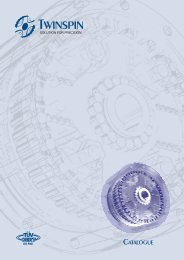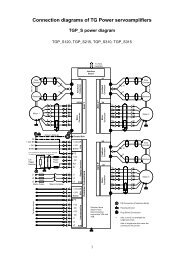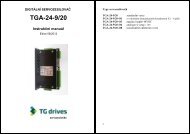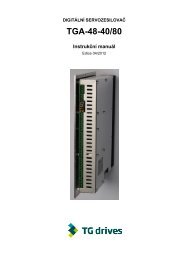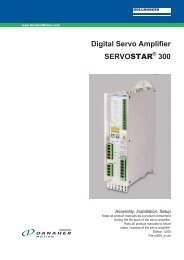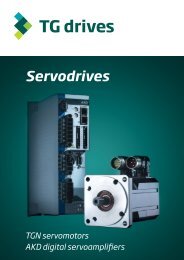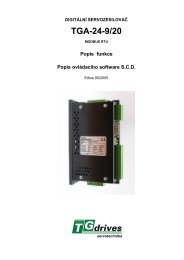Table of Contents - TG Drives
Table of Contents - TG Drives
Table of Contents - TG Drives
You also want an ePaper? Increase the reach of your titles
YUMPU automatically turns print PDFs into web optimized ePapers that Google loves.
EXTENDED REGISTER GROUPS<br />
LAN1, LOCAL AREA NETWORK 1<br />
Group Group<br />
No.<br />
LAN1, Local area network 1<br />
Description<br />
LAN1 28 Local area network group. LAN channel number 1.<br />
This group is the interface to the Local Area<br />
Network.<br />
The OSI reference model for LAN communication:<br />
Application layer<br />
Presentation layer<br />
Session layer<br />
Transport layer<br />
Network layer<br />
Datalink layer<br />
Physical layer<br />
LAN1, INTERRUPT HANDLING<br />
There are two types <strong>of</strong> interrupts that can be generated by the LAN1 group.<br />
1. Net Error When the LAN1 low level protocol (the CAN chip) detects an<br />
error it will go bus <strong>of</strong>f. For this event the system will generate a<br />
PL interrupt and execute the code specified at<br />
LAN1.ErrVector.<br />
This interrupt is always enabled but if a user does not specify<br />
any line where to execute PL code, leaving<br />
LAN1.ErrVector = 0, then the CAN communication line will<br />
only go bus <strong>of</strong>f and no other action will be done by the<br />
firmware. A user can specify what action to take, when an error<br />
occurs in a PL written interrupt routine.<br />
2. Message<br />
Object interrupt<br />
A message object that has either been received or transmitted<br />
can generate an interrupt.<br />
The PL service routine is specified in the<br />
MsgObjLan1.Vector when<br />
the object is defined.<br />
The following must be done before any LAN1 related interrupts<br />
will be generated:<br />
1. A MsgObjLan1.xx must be initialized<br />
and mapped to a priority<br />
level. The MsgObjLan1.Vector member<br />
must have a valid<br />
PL code line # at the time when the SetObjLan1 instruction is<br />
used to program the priority level.<br />
2. The corresponding LAN1.Mask bit for the level used must be<br />
set.<br />
3.<br />
The Vector.Cascade1 member must be set to<br />
LAN1.Handler<br />
4. The Int.SysMask must be set to enable<br />
the<br />
Vector.Cascade1. Before enabling Vector.Cascade1, a<br />
user should clear all bits in LAN1.Pend and the bit for the<br />
Vector.Cascade1 in Int.SysPend, to avoid generating<br />
interrupt on old events.<br />
User's Manual 5.1 Inmotion Technologies AB<br />
Doc. No.9032 0027 01 (B), Rev. 11.07.2001<br />
139



